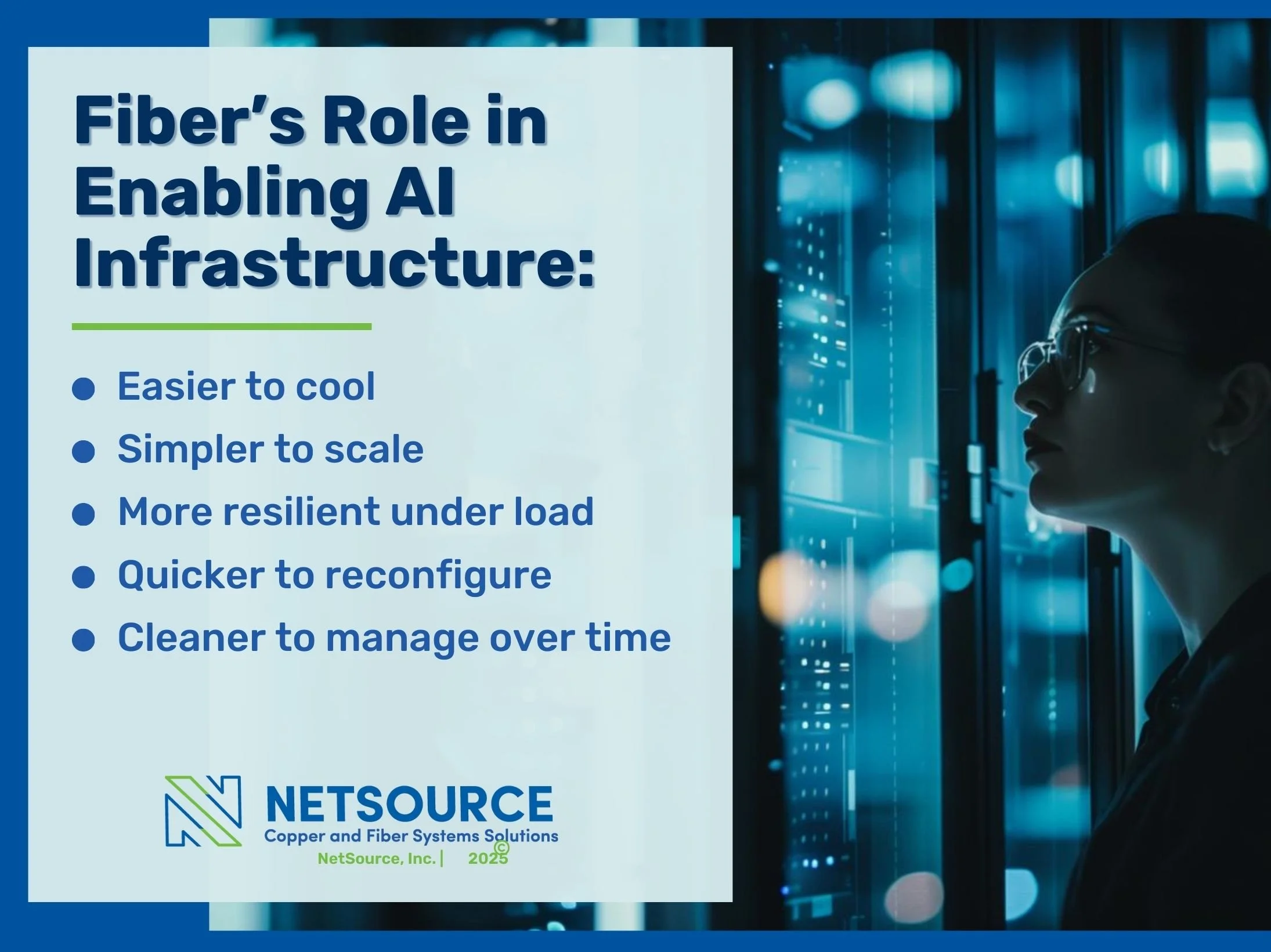What AI Means for Data Center Infrastructure: Why Fiber Matters More Than Ever
AI is everywhere these days. If you've glanced at the news or skimmed a conference agenda, it's the headline and the footnote. But for the people responsible for building and maintaining real infrastructure, AI isn’t an idea. It’s a set of pressures. That’s why at NetSource, we’ve been listening closely to the teams tasked with keeping ports lit, racks breathable, and upgrade paths open.
Heavier workloads. Hotter racks. Denser port counts. And nonstop traffic between machines that now need to think faster, not just communicate.
It’s not just about compute. AI’s real footprint lands in power, cooling, and physical pathways—especially the cabling infrastructure that ties everything together.
Clients aren’t asking about AI roadmaps. They’re asking how to keep ports lit, racks breathable, and upgrade paths open.
This post isn’t about the promise of AI. It’s about the very real changes happening inside the walls and ceilings of data centers trying to keep up.
AI Doesn’t Float in the Cloud. It Bottlenecks in the Rack
Let’s ground this. AI doesn’t just “run in the cloud.” It runs on silicon. And silicon lives in buildings full of cables.
Generative AI, inference clusters, and training workloads have brought a new flavor of heat to the network layer. More GPUs mean more east-west traffic. More east-west traffic means higher aggregate bandwidth. And more bandwidth means more links. Or more efficient ones.
This isn’t theoretical. Hyperscale sites are already shifting toward architectures that prioritize:
Low-loss optical backbones
High-density fiber trunks
Greater port accessibility and modular cabling
Even mid-market deployments are starting to mirror these concerns. The issue is no longer about peak speed. It’s about stackable, supportable, sustainable throughput that doesn’t eat up floor space or air capacity.
Consider a typical AI refresh cycle for a regional co-location facility. New racks arrive with high-density GPU chassis that double east-west bandwidth needs overnight. Suddenly, what was a “well-designed” copper/fiber hybrid is now a liability. Patch fields are crowded, link budgets are fragile, and lead times on pre-terminated fiber trunks can’t keep up. These moments drive infrastructure leaders to rethink not just what they install, but how they plan for what’s next.
It’s worth noting that the same challenges are creeping into enterprise deployments, too. As organizations adopt smaller-scale AI models, they’re discovering that their network layers weren’t designed for the volume of east-west traffic those models generate. Bandwidth demand isn’t just peaking. It’s pulsing in unpredictable cycles, putting strain on cable trays, switching fabric, and power distribution alike.
Why Fiber Isn’t Just “Faster.” It’s Smarter Infrastructure
Speed is only part of the story. The move to fiber in AI-sensitive environments is driven by a combination of physical and operational realities:
Space efficiency: High-density MTP/MPO connectors reduce cable volume, free up airflow paths, and support easier access.
Thermal performance: Fiber generates less heat and reduces airflow resistance. This is a key consideration in AI-accelerated zones where cooling is already maxed.
EMI immunity: Fiber avoids the signal degradation and interference issues common in copper-heavy trays.
Upgrade flexibility: Modular panel systems and scalable trunk designs simplify transitions from 10G to 40G to 100G and beyond.
Fiber doesn't just deliver performance. It extends the lifespan and modularity of the environment it lives in.
And unlike copper, fiber doesn't punish you later when density increases or roles shift.
Teams who have made the switch to fiber-first architectures often report improved visibility, faster moves/adds/changes, and fewer post-deployment surprises. Not because fiber solves everything, but because it provides a cleaner baseline for evolution.
Designing for What’s Coming, Not Just What’s Here
Data centers rarely fail because of today’s traffic. They fail because of tomorrow’s expectations.
Designing with fiber-first principles gives infrastructure teams breathing room. It allows planning for:
Uncertain growth trajectories
Shorter deployment windows
Hybrid workloads with volatile bandwidth requirements
Take a representative example. A mid-sized enterprise data center begins onboarding AI-enhanced video analytics platforms. The team doesn’t yet know how aggressively the workload will scale, but wants to avoid disruptive retrofits later. By shifting to a modular fiber architecture—with scalable trunks, labeled patch frames, and built-in slack capacity—they future-proof their space with minimal upfront cost.
This is exactly the kind of planning NetSource supports. Our teams collaborate with integrators, contractors, and IT stakeholders to develop made-to-order fiber systems that match specific topology, timing, and termination preferences. And because everything is built and assembled in the U.S., timelines are predictable.
We also see a growing number of clients using this moment to clean up legacy chaos. Moving from patchwork cabling to modular fiber systems reduces the risk of costly outages, speeds up troubleshooting, and makes it easier to train new team members on layout logic. When AI-driven platforms demand uptime, those day-to-day operational gains matter more than ever.
What Fiber Enables in AI Deployments
To summarize, fiber infrastructure doesn’t just “handle” AI. It enables it by making data center networks:
Easier to cool
Simpler to scale
More resilient under load
Quicker to reconfigure
Cleaner to manage over time
It turns a reactive scramble into a manageable system. That system becomes the backbone of innovation.
Closing Thoughts: Don’t Build for the Buzz. Build for the Load.
AI might be the acronym, but what it really brings is infrastructure stress. Fiber isn’t a futureproofing gimmick. It’s a practical response to the way networks are evolving.
If you’re architecting systems that need to grow, flex, and perform under pressure, fiber deserves more than a line item. It deserves a conversation.
And if you're looking for that conversation, we're ready when you are.



